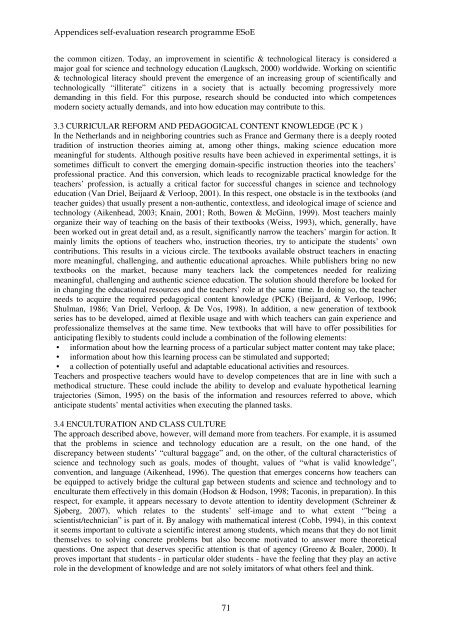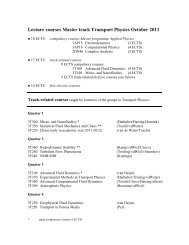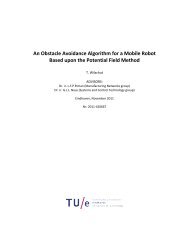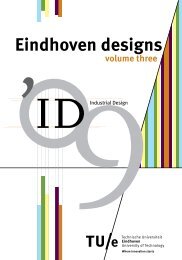Self-evaluation - Technische Universiteit Eindhoven
Self-evaluation - Technische Universiteit Eindhoven
Self-evaluation - Technische Universiteit Eindhoven
You also want an ePaper? Increase the reach of your titles
YUMPU automatically turns print PDFs into web optimized ePapers that Google loves.
Appendices self-<strong>evaluation</strong> research programme ESoE<br />
the common citizen. Today, an improvement in scientific & technological literacy is considered a<br />
major goal for science and technology education (Laugksch, 2000) worldwide. Working on scientific<br />
& technological literacy should prevent the emergence of an increasing group of scientifically and<br />
technologically “illiterate” citizens in a society that is actually becoming progressively more<br />
demanding in this field. For this purpose, research should be conducted into which competences<br />
modern society actually demands, and into how education may contribute to this.<br />
3.3 CURRICULAR REFORM AND PEDAGOGICAL CONTENT KNOWLEDGE (PC K )<br />
In the Netherlands and in neighboring countries such as France and Germany there is a deeply rooted<br />
tradition of instruction theories aiming at, among other things, making science education more<br />
meaningful for students. Although positive results have been achieved in experimental settings, it is<br />
sometimes difficult to convert the emerging domain-specific instruction theories into the teachers’<br />
professional practice. And this conversion, which leads to recognizable practical knowledge for the<br />
teachers’ profession, is actually a critical factor for successful changes in science and technology<br />
education (Van Driel, Beijaard & Verloop, 2001). In this respect, one obstacle is in the textbooks (and<br />
teacher guides) that usually present a non-authentic, contextless, and ideological image of science and<br />
technology (Aikenhead, 2003; Knain, 2001; Roth, Bowen & McGinn, 1999). Most teachers mainly<br />
organize their way of teaching on the basis of their textbooks (Weiss, 1993), which, generally, have<br />
been worked out in great detail and, as a result, significantly narrow the teachers’ margin for action. It<br />
mainly limits the options of teachers who, instruction theories, try to anticipate the students’ own<br />
contributions. This results in a vicious circle. The textbooks available obstruct teachers in enacting<br />
more meaningful, challenging, and authentic educational aproaches. While publishers bring no new<br />
textbooks on the market, because many teachers lack the competences needed for realizing<br />
meaningful, challenging and authentic science education. The solution should therefore be looked for<br />
in changing the educational resources and the teachers’ role at the same time. In doing so, the teacher<br />
needs to acquire the required pedagogical content knowledge (PCK) (Beijaard, & Verloop, 1996;<br />
Shulman, 1986; Van Driel, Verloop, & De Vos, 1998). In addition, a new generation of textbook<br />
series has to be developed, aimed at flexible usage and with which teachers can gain experience and<br />
professionalize themselves at the same time. New textbooks that will have to offer possibilities for<br />
anticipating flexibly to students could include a combination of the following elements:<br />
• information about how the learning process of a particular subject matter content may take place;<br />
• information about how this learning process can be stimulated and supported;<br />
• a collection of potentially useful and adaptable educational activities and resources.<br />
Teachers and prospective teachers would have to develop competences that are in line with such a<br />
methodical structure. These could include the ability to develop and evaluate hypothetical learning<br />
trajectories (Simon, 1995) on the basis of the information and resources referred to above, which<br />
anticipate students’ mental activities when executing the planned tasks.<br />
3.4 ENCULTURATION AND CLASS CULTURE<br />
The approach described above, however, will demand more from teachers. For example, it is assumed<br />
that the problems in science and technology education are a result, on the one hand, of the<br />
discrepancy between students’ “cultural baggage” and, on the other, of the cultural characteristics of<br />
science and technology such as goals, modes of thought, values of “what is valid knowledge”,<br />
convention, and language (Aikenhead, 1996). The question that emerges concerns how teachers can<br />
be equipped to actively bridge the cultural gap between students and science and technology and to<br />
enculturate them effectively in this domain (Hodson & Hodson, 1998; Taconis, in preparation). In this<br />
respect, for example, it appears necessary to devote attention to identity development (Schreiner &<br />
Sjøberg, 2007), which relates to the students’ self-image and to what extent ‘”being a<br />
scientist/technician” is part of it. By analogy with mathematical interest (Cobb, 1994), in this context<br />
it seems important to cultivate a scientific interest among students, which means that they do not limit<br />
themselves to solving concrete problems but also become motivated to answer more theoretical<br />
questions. One aspect that deserves specific attention is that of agency (Greeno & Boaler, 2000). It<br />
proves important that students - in particular older students - have the feeling that they play an active<br />
role in the development of knowledge and are not solely imitators of what others feel and think.<br />
71

















